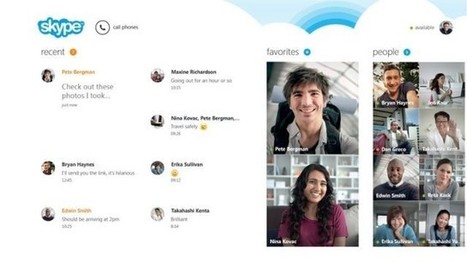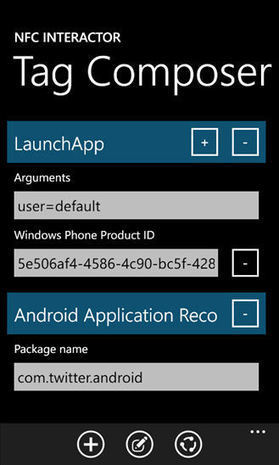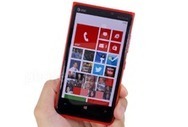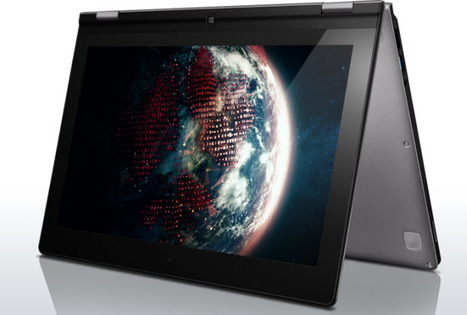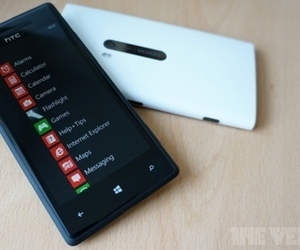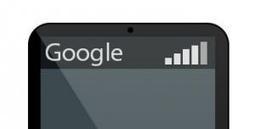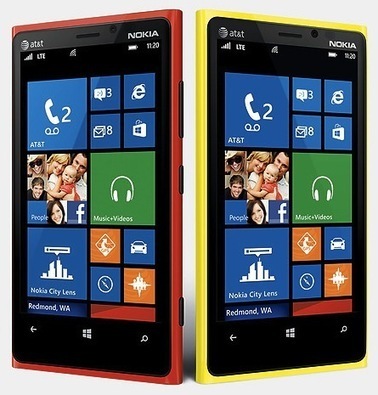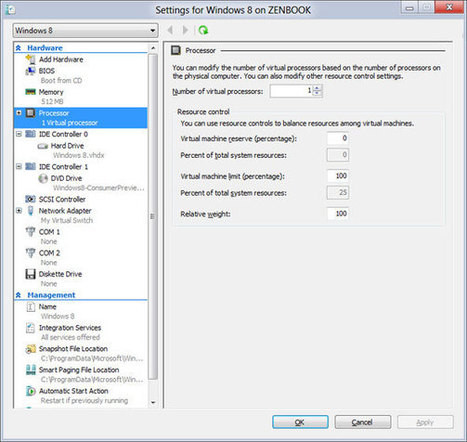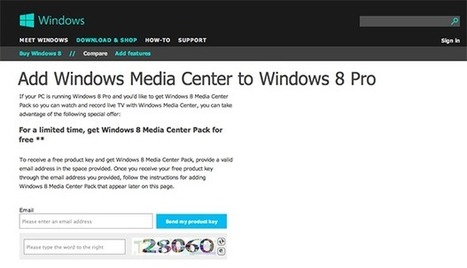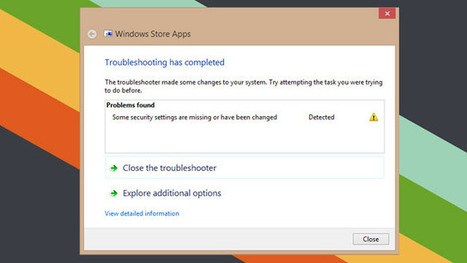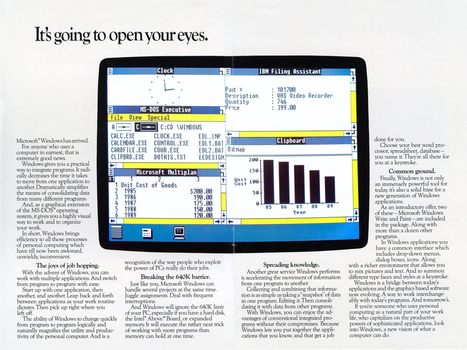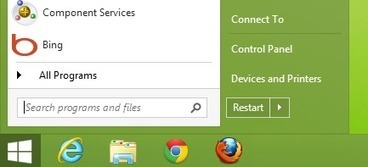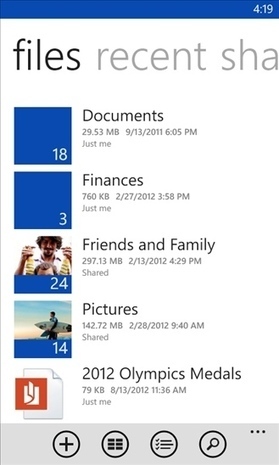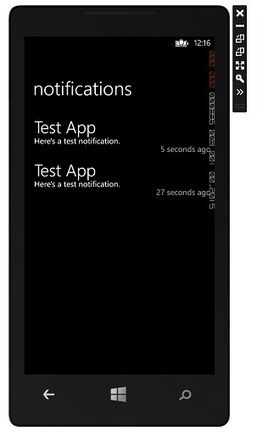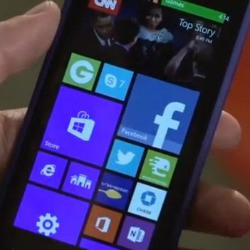 Your new post is loading...
 Your new post is loading...

|
Scooped by
Thomas Kalhauge
November 24, 2012 10:14 AM
|
If you want the most powerful, feature-rich Windows phone available, then pick the Nokia Lumia 920. But if you're looking for a slim, light smartphone, you'll find the 920's cumbersome dimensions a drag.

|
Scooped by
Thomas Kalhauge
November 22, 2012 1:41 AM
|
Microsoft has announced the release of the Windows Phone 8 version of the Windows Phone Toolkit. The Windows Phone Toolkit provide an additional package of controls that developers can use with the Windows Phone SDK to easily add useful controls to your Windows Phone app.

|
Scooped by
Thomas Kalhauge
November 20, 2012 4:59 PM
|
Microsoft has launched a new and major update for the Skype app for Windows 8, offering up some new features for the VoIP app such as being able to search for people and groups.

|
Scooped by
Thomas Kalhauge
November 20, 2012 4:24 PM
|
One of the hardware improvements in Windows Phone 8 is support for NFC. Devices like the HTC 8X, Lumia 920 and Samsung ATIV S can use NFC to trigger the sharing of media (Tap+Send), pair with Bluetooth accessories, read NFC tags (e.g.... The reading of NFC tags offers a wide variety of possibilities, from viewing a string of text, to triggering an action on the phone (e.g. opening a web address, open a specified app, and more). It's also possible to write your own tags, but to do this you'll need a helper app. One of the first of this type of app that we've seen for Windows Phone 8 is Nfc Interactor. The Nfc Interactor app, from Mopius, can read any NFC tag and will show information about the data stored on the tag, and the writeable size of the tag, in an easy to read layout. That's useful for developers working with NFC tags, but may also be of interest to the NFC enthusiast. Potentially more useful is the ability to write data to programmable NFC tags. Nfc Interactor can be used to write a variety of formats to including Smart Poster, URI, Text, Social Networks (Twitter, Facebook, Skype, etc.), SMS, Telephone call, Geo Tags, LaunchApp (for Windows 8 and Windows Phone 8), Android Application Record, Nokia Accessories, and Custom Records. This functionality can be used to create your own custom NFC tags. For example, you could create a tag that opens up an alarm app and place it next to your bed, or you you could write tag that triggers a call to a regularly called number. Windows Phone Store description: Nfc Interactor is a powerful Near Field Communication tag reader / writer app, aimed at enthusiasts and developers. Tap NFC tags to analyze their real contents. Nfc Interactor will instantly tell you the writable tag size and parse standardized messages to human readable form. Write your own NFC tags using a dynamic message editor - including Smart Posters, geo tags, social networks and LaunchApp tags. Additionally, you can also send your messages to other NFC devices simply by tapping. Nfc Interactor can be downloaded from the Windows Phone Store. A free trial is available (limited to writing 10 NFC tags), with the full version costing £1.49 / $1.99 / €1.99. Developers will be interested to know that the core NDEF (NFC Data Exchange Format) library used by Nfc Interactor is available as open source through CodePlex. This has the potential to save significant amounts of time and effort when implementing NFC solutions on Windows Phone 8 and Windows 8.

|
Rescooped by
Thomas Kalhauge
from Nokia, Symbian and WP 8
November 20, 2012 8:14 AM
|
According to the reports from various WP forum, some Nokia Lumia 920 owners are experiencing random reboots and poor battery life and some attempts to...

|
Scooped by
Thomas Kalhauge
November 20, 2012 1:29 AM
|
Building a PC should be easy. Design great hardware, add an operating system and any specialized tools that your hardware needs, and delight the user. So why do some PC makers insist on screwing things up? How can PC makers screw up perfectly good PC designs? Their bag of tricks is seemingly endless, from cutting costs by specifying inferior hardware to loading new PCs with performance-sapping crapware. But there's another stupid OEM trick you might not have run into: the incredible shrinking hard disk. I stumbled across an example earlier this month when I read Walt Mossberg’s review of the new Lenovo IdeaPad Yoga 13. Mossberg praised Lenovo for the innovative design of this hybrid notebook, which can fold into seemingly impossible positions (thus the name) to work as a tablet or as a touch-first display with the keyboard portion acting as a stand, or in Tent Mode, as shown here. ...

|
Scooped by
Thomas Kalhauge
November 19, 2012 3:47 AM
|
Windows Phone 8 devices have been available since the beginning of the month and users are starting to report early issues across HTC and Nokia handsets. In a thread over at WPCentral with 143, a variety of HTC 8X users report that handsets randomly reboot while in use. A thread on Microsoft's own support forums has also gained 50 replies complaining about the issues. The Verge can confirm that an 8X we are testing has rebooted on more than one occasion. Nokia Lumia 920 users are also reporting random reboots and freezes, with some complaining of poor battery life too. In a thread on Nokia's support forums, a number of users appear to be complaining of lock ups and resets with the Lumia 920. Battery life issues have led to some users wiping their devices in hope of a quick fix, unfortunately that seems to have resulted in some devices left stuck on a Nokia splash screen. In our own experience with several Windows Phone 8 devices, we've found that disabling the tap + send (NFC) feature results in improved battery life. We have reached out to Microsoft, HTC, and Nokia to discuss the issues and we'll update you accordingly.

|
Scooped by
Thomas Kalhauge
November 19, 2012 2:56 AM
|
L'Avenir de l'Artois - Depuis toujours Google s'accapare des domaines liés aux nouvelles technologies. Depuis toujours Google s'accapare des domaines liés aux nouvelles technologies. Ayant commencé comme simple moteur de recherche, la société s'est agrandit au point de prendre de plus en plus de parts de marchés dans d'autres domaines.
On retrouve par exemple le système Android racheté plus tôt par la firme de Mountain View sur énormément de smartphone notamment ceux produits par Samsung. De plus, Google dispose désormais de son propre réseau internet, le rendant indépendant des fournisseurs d’accès disponibles aux Etats-Unis. Actuellement ce réseau privé est en test à Kansas City, surement parce qu’ils envisagent de rendre leur réseau public et de l’étendre. Ainsi on peut se demander pourquoi est-ce qu’ils ne s’attaqueraient pas au domaine du réseau mobile ? En effet, Google à rencontrer Dish Network, une société s’occupant de diffuser des contenus télévisuels grâce aux satellites, pour « discuter » d’un éventuel partenariat afin de lancer un nouveau réseau mobile. Ce projet aura pour but de concurrencer Verizon et AT&T, les deux géants de ce domaine, basés aux US. Même si rien de concret n’est pour l’instant envisagé, on peut tout de même se demander si le géant de l’informatique va se lancer dans ce domaine très convoités sans expériences. Et, pourquoi pas, nous offrir un nouveau système de forfais, après tout Google est connus pour son innovation dans les modèles économiques.

|
Scooped by
Thomas Kalhauge
November 18, 2012 5:30 AM
|
Regular readers will know that I'm a fan of removeable batteries in smartphones. There's being able to swap in a new cell at any time, to replace an ailing one or simply to pull the battery if something goes horribly wrong. With many of today's sealed designs, that last is now impossible, and as Mike Macias discovered, the long press of doom on the power key doesn't always work either. The solution? Use what is apparently a Windows Phone 8 standard reset combo - volume and power held down together. Quote below. The [lock up] happened to my Nokia Lumia 920 this morning when trying to launch the ESPN ScoreCenter app from my start screen. I’m not sure what might have caused the lockup, but whatever it was made the screen freeze in that state. I tried holding down the power button for 10 seconds but that did not work. After doing some research online I discovered a way to reboot the phone when it freezes up. This applies to all Windows Phone devices, not just the newer ones. Simply hold the lock button and volume down button at the same time for 5-10 seconds. Once the phone reboots you can now get back into the operating system and make sure everything is normal. This should not affect your settings, messages, photos, contacts, etc. This function simply reboots your phone without forcing you to do a backup, although it’s highly recommended to back up your phone often. Good to know. So that's two possible key operations to try when your Windows Phone device freezes harder than ice cream in Antarctica. Mind you, I still hanker for being able to pull the battery though.... mutter, mutter.... Source / Credit: The Mobile Fanatics

|
Scooped by
Thomas Kalhauge
November 17, 2012 2:49 PM
|
TechMobility: Why not releasing WP 7.8 in 2012 would be a huge mistake... Seeing the new features that WP 8 had brought left WP 7 device owners' mouths watering. Releasing the WP 7.8 update in 2013 would be an immense mistake. Here's why. Imagine yourself buying a brand new Nokia 900. A few short months after, you find out your brand new phone just became a legacy device. You inherently build up some frustration. Microsoft then promises to launch this update for old phones that will bring some if the features from WP 8. You're still uneasy, but you start thinking it's better than no update at all right? So Microsoft launches WP 8 and you're waiting eagerly for your promised update. You would expect it to come shortly after the WP 8 launch right? Wrong. The update is nowhere to be found and Microsoft issues no official statement about it. The question Microsoft has to as themselves is this: will existing customers wait for the update to arrive in 2013 or will they take advantage of the holidays offers and get a new device? And if they do get s new device, will it be a WP device? At this point cheap WP 7 devices cannot compete with cheap Android devices. And I bet that the people who decide to get a new device won't buy one powered by an OS from the same company that left them on the dust and got them to change their phones in the first place right? It's logic. Plain and simple. So the problem is simple. Release the update and you keep you users happy, and even get new ones for both cheap and expensive devices. Don't and you'll see users flea to other platforms and be sure those deserters are never coming back.

|
Scooped by
Thomas Kalhauge
November 16, 2012 12:06 PM
|
A few weeks ago, we took the wraps off of Bing on Windows Phone 8, designed from the ground up to keep you closer to what matters most by helping you search less and do more while you’re on the go. You can watch Stefan demo some of our favorite features in the following video: Bing Explore: New to Windows Phone 8, you can now easily swipe the Bing home page across to see content relevant to you, including trending stories, local deals and more.
Take the Bing Homepage with you: Now you can take the iconic Bing Homepage with you. The lock screen image on Windows Phone 8 automatically retrieves the image of the day so you have something fresh, beautiful and dynamic to look forward to at the start of everyday.
App Connect and Store Search: Ever wonder which app does what? Bing has you covered. Bing search results now return Windows Phone Store apps that are relevant to what you’re searching. For example, when you search for movie times, Bing will show you several of the top movie apps. Bing also powers search for both apps and games in the Store. This system has also been rolled out to Windows Phone 7.x devices.
- The Bing Team

|
Scooped by
Thomas Kalhauge
November 15, 2012 1:43 PM
|
When we're asked this question, what do you say? ..... Like it or not, smartphones have become very personal items for most people. They become attached to them quickly, and usually stick with a particular brand. Iphone 4S owners maintain the Apple ecosystem link by purchasing the iPhone 5. Samsung Galaxy S II owners upgrade to the S III, and so on. There is a much more tangible connection between people and their smartphones than they’re prepared to admit. It’s not as if people are particularly attached to the Dell brand, for example, they just need a good PC or laptop. The next one could very well be an HP or Asus. Phones have become that thing that we have to help identify who we are; why we stick with a Honda over a Ford for example. Nokia is one of those brands that people choose not because of prestige necessarily, but because they have likely stuck with that brand for many years. And in that time Nokia have shown us the excellence they are capable of (most of the time!) It seems very apparent that they are maintaining this excellence with the new Lumia 920, and I think you’d be hard pushed to disagree with that, whether you’re a Windows Phone fan or not. The device itself is stunning. The thing about Nokia phones is this: describing your current one as stunning could easily be something you’ve been saying for a long, long time. And so when I’m asked the question, “Why Nokia?”…that’s why.

|
Scooped by
Thomas Kalhauge
November 15, 2012 11:13 AM
|
With Windows 8, Microsoft has replaced the lackluster Windows Virtual PC solution with the powerful Hyper-V capabilities from Windows Server 2012. This is an amazing change, but it somewhat limits how virtualization works in Windows 8That is, instead of focusing on application compatibility, Hyper-V in Windows 8 is aimed at software development test environments and IT pros who are managing environments based on Microsoft’s enterprise virtualization solutions. Aside from lacking Windows Virtual PC’s XP Mode and its attendant application virtualization niceties, Client Hyper-V, as Microsoft calls it, is more capable and powerful than its predecessor. It offers much better performance and lets you run multiple virtual machines simultaneously. It works with both 32-bit and 64-bit operating systems, and not just 32-bit like Virtual PC. And it comes with an amazing management interface, just like the version from Windows Server. (In fact, they’re identical.) This means that your experience using Client Hyper-V in Windows 8 will be directly applicable to Windows Server 2012 as well. Hyper-V is so powerful, in fact, that it comes with very specific system requirements. 64-bit PCs only. Like the Server software on which it is based, Client Hyper-V only runs on 64-bit PCs that are running the 64-bit version of Windows 8 Pro (or Enterprise). Chipset requirements. Client Hyper-V requires modern Intel and AMD microprocessors that include Second Level Address Translation (SLAT) technologies. Fortunately, this is a feature of all current generation (“Sandy Bridge” on Intel) microprocessors. But it means that your older Core 2 Duo-based PCs may not work. Memory. Your PC must be configured with at least 4 GB of RAM. Of course, more is always better with virtualization, so if your needs are high-end, you’ll want more RAM than that. To install Client Hyper-V, you use the well-hidden Windows Feature control panel. (Thanks to the wonders of Start Search in Windows 8, however, it’s easily found if you know what you’re looking for: Search for windows features, filter to Settings, and select Turn Windows features on or off.)... .
|

|
Scooped by
Thomas Kalhauge
November 22, 2012 1:43 AM
|
Forget torrents, just go and download as many Windows 8 keys that you need, from Microsoft directly. You want a copy of Windows 8 Pro? Go ahead and download it -- Microsoft is giving the keys away for free. According to VentureBeat, an interesting exploit on Microsoft's download page allows users to pick up a free copy of Windows 8 Pro -- directly from the website, and at no cost. If you attempt to download the free Microsoft Windows Media Center upgrade, which is being offered until January 31 next year, a strange side effect takes hold. Windows 8 Pro will be permanently activated .For the pirates among us, this would provide a handy workaround for the tech giant's Key Management Service (KMS). Built for enterprise users, the KMS is intended to make deployment of Windows 8 through a KMS host and KMS client, making Windows 8 fully usable for 180 days before activation. In other words, instead of being required to input an activation key or reach Microsoft authentication channels on each individual computer, businesses can activate Windows copies on a local network and make the transition step-by-step. Within the enterprise, making Windows deployment processes easier can only be a good thing. However, this does mean that by setting up pirate KMS servers, keys can be traded across the Internet for free. One feather in Microsoft's cap, however, is that Windows has to be reactivated every 180 days using this method. Volume keys are no longer in use, and so each individual PC needs a unique key -- and so 'legitimate' activation cannot be achieved through multiple users activating through the same key. Therefore, pirateers have had to come up with more complex methods, possible through the KMS system, but more time-consuming than simply downloading a Windows Media Center upgrade. Once you've reached the desktop within the Windows 8 Pro installation and after applying a KMS key, using the new Windows Media Center upgrade key -- obtained for free by Microsoft's website -- does not result in a validity check. Therefore, any version of Windows 8 Pro, whether obtained through a pirate KMS network or not, will become fully active and 'legitimate'. Stephen Hall at Windows Wave originally reported the exploit, and was able to confirm it works, at least for now. Reddit user noveleven explained on a discussion thread why the method, in theory, works: "When you activate Windows via KMS, in the activation window it says "Windows is activated until…" and a date (so if you were to install it today, it would say it's activated until May). After installing the upgrade, the window just says "Windows was activated on…" and the date of activation. That means the activation is permanent. When you install the upgrade key, that replaces the existing product key; only the new upgrade key is used for future checks. Windows won't check the key you used to install because it no longer has it."
ZDNet has reached out to Microsoft and will update the piece if we hear back.

|
Scooped by
Thomas Kalhauge
November 21, 2012 1:17 AM
|
Windows: If you're having problems with a Windows 8 Store app and nothing is working, Microsoft offers a few troubleshooting tips, as well as a utility that can automatically find and fix app problems for you—even ones you're not aware of. Most of the time, Microsoft says, the Windows Store will automatically tell you if there's a problem with an app and will try to fix it. However, some Microsoft support forum users are reporting Windows 8 errors such as failed Windows Updates and apps not working after upgrading from Windows 7. Microsoft's troubleshooting advice? Update the app, sync its license, or reinstall it (go to Store > Settings > App updates to update or sync licenses. To reinstall, swipe down on or right-click the app and choose to uninstall it then download it again from the Windows Store). An easier automated option is to just grab Microsoft's Apps troubleshooter. When I ran it, the utility found some missing security settings I didn't even know about and automatically reset them for me. ...

|
Scooped by
Thomas Kalhauge
November 20, 2012 4:30 PM
|
1985 is calling, and it has some lessons for Windows 8...
Two years ago today, when Windows 1.0 celebrated its 25th birthday, we didn’t yet know what the future of Windows would hold. Now that Windows 8 is on the market, the original is more relevant than ever before. Today, Windows 1.0 turns 27, and despite the many ways computing has changed since its debut, the two operating systems have some surprising similarities. Let’s take a look at just how far we’ve come since Windows 1.0… and where Microsoft is retracing its own footsteps with the latest version of Windows.
On November 10th, 1983, Microsoft announced Windows. For $99, it came with a notepad, calendar, clock, cardfile, terminal application, file manager, a game of Reversi, Windows Write, and Windows Paint. The original press materials, prepared using Windows Write, had this quote from Bill Gates: “Windows provides unprecedented power to users today and a foundation for hardware and software advancements of the next few years. It is unique software designed for the serious PC user, who places high value on the productivity that a personal computer can bring.” ... ...Also like Windows 8, the original version of Microsoft’s operating system had a potential problem getting software developers to build for the new paradigm. In November 1983, shortly after the Windows reveal, InfoWorld’s John Markoff rooted out an issue right away: a significant number of programs would “misbehave” in the windowed mode, and take up the entire screen. The New York Times questioned the value of windowed environments, period, in a 1984 editorial. When InfoWorld asked IT managers at a number of companies about whether they would adopt Windows in February 1986, these were the replies they received. Then as now, companies seemed happy enough with what they had, and worried about how Windows might have a fragmented user experience if software manufacturers don’t follow standards. Then as now, critics suggested...

|
Scooped by
Thomas Kalhauge
November 20, 2012 2:49 PM
|
Bring back the Windows Start menu with Start8! Return the Start Button to Windows 8
-Windows 7-style Start menu with Windows 8 enhancement
-Search for Windows 8-style (Modern UI) apps
-Pin desktop and Metro apps to the start menu
-Jump List support
-Unified Search for apps, settings and files
-Boot directly to the Windows 8 desktop
-One click access to shut down, devices, music, documents, and videos

|
Scooped by
Thomas Kalhauge
November 20, 2012 2:08 AM
|
The Complete List of Windows 8 Keyboard Shortcuts
Posted by Shaan Haider on 4:35 PM in Tips, Windows | 0 comments Windows 8 is one of the most wanted software these days and just in few weeks, millions of copies of Windows 8 are sold. But since Windows 8 is totally different in terms of user interface with respect to the previous versions of the Windows, many people are finding it hard to work on it. In Windows 8, there are lots of new and updated keyboards shortcuts available. Few of them perform the same functionality like the previous Windows versions and few of them are with totally new functionalities. So if you are having a Windows operated system with a keyboard instead of the touchscreen then, all these Windows 8 keyboard shortcuts will help you for better productivity and performance. Windows key shortcuts in Windows 8 Windows key : To switch between the Modern Desktop Start screen and the last accessed application Windows key + C : To access the Charms bar Windows key + Tab : To access the Modern Desktop Taskbar Windows key + I : To access the Settings charm Windows key + H : To access the Share charm Windows key + K : To access the Devices charm Windows key + Q : To go to the Apps Search screen Windows key + F : To visit the Files Search screen Windows key + W : To go to the Settings Search screen Windows key + P : To access the Second Screen bar Windows key + Z : It brings up the App Bar when you have a Modern Desktop App running Windows key + X : To access the Windows Tools Menu Windows key + O : To lock the screen orientation ... ...

|
Scooped by
Thomas Kalhauge
November 19, 2012 10:22 AM
|
When you pick up your new Windows Phone 8 smartphone, don't forget to download Microsoft's SkyDrive client. The file manger of your cloud account has been polished up to v3.0 for Windows Phone 8 handsets, allowing files, photos, and videos to be uploaded and downloaded to the cloud. The updated version (which is currently only available for Windows Phone 8, WP7.x users are still on version 2.2) adds the following: Search your SkyDrive files and folders.
New settings for photo upload and download size.
Support for Windows Phone 8.
Updated app icons and visuals.

|
Scooped by
Thomas Kalhauge
November 19, 2012 3:27 AM
|
En effet, vous le savez sûrement, le 21 novembre 2012 se tiendra à Paris une conférence de presse appelée Innovation Day qui verra le lancement de la nouvelle box de l'opérateur historique. Et si le secret fut bien gardé jusque là, c'est Mr Richard qui donné un os a ronger à nous autres journalistes bloggueurs. Il a donc annoncé à nos confrères et consoeurs du JDD que la Livebox Play et son décodeurs TV bénéficieront d'une télécommande radiofréquence et gyroscopique ainsi qu'un lecteur Blu Ray 3D. Elle s'approcherait donc en grande partie de la Freebox Revolution en espérant que cette conférence de presse nous réserve quelques bonnes surprises. Parmis les potentielles surprises, il y a le choix, en effet il y a de grandes chances pour que nous puissons avoir le choix entre un box blanche ou noire. Si ce point reste anecdotique pour les plus geeks d'entre nous, cela peut intéressant pour la ménagère qui souhaite accorder le high tech avec son intérieur. Autre nouveauté hypothétique, la box pourrait intégrer un écran tactile afin d'accèder à l'interface de gestion de la Livebox Play. Ce même écran tactile pourrait être synchronisé à nos dossiers photos afin de servir de cadre photo numérique. ...

|
Scooped by
Thomas Kalhauge
November 19, 2012 2:42 AM
|
Hidden features, reduced discoverability, cognitive overhead from dual environments, and reduced power from a single-window UI and low information density. Too bad. With the recent launch of Windows 8 and the Surface tablets, Microsoft has reversed its user interface strategy. From a traditional Gates-driven GUI style that emphasized powerful commands to the point of featuritis, Microsoft has gone soft and now smothers usability with big colorful tiles while hiding needed features. The new design is obviously optimized for touchscreen use (where big targets are helpful), but Microsoft is also imposing this style on its traditional PC users because all of Windows 8 is permeated by the tablet sensibility. How well does this work for real users performing real tasks? To find out, we invited 12 experienced PC users to test Windows 8 on both regular computers and Microsoft's new Surface RT tablets. Double Desktop = Cognitive Overhead and Added Memory Load The Roman god Janus; Dr. Jekyll and Mr. Hyde; even Batman's arch-foe Two-Face — human culture is fascinated by duality. We can now add Windows 8 to this list. The product shows two faces to the user: a tablet-oriented Start screen and a PC-oriented desktop screen.
Unfortunately, having two environments on a single device is a prescription for usability problems for several reasons: Users have to learn and remember where to go for which features.
When running web browsers in both device areas, users will only see (and be reminded of) a subset of their open web pages at any given time.
Switching between environments increases the interaction cost of using multiple features.
The two environments work differently, making for an inconsistent user experience.
Lack of Multiple Windows = Memory Overload for Complex Tasks One of the worst aspects of Windows 8 for power users is that the product's very name has become a misnomer. "Windows" no longer supports multiple windows on the screen. Win8 does have an option to temporarily show a second area in a small part of the screen, but none of our test users were able to make this work. Also, the main UI restricts users to a single window, so the product ought to be renamed "Microsoft Window."
The single-window strategy works well on tablets and is required on a small phone screen. But with a big monitor and dozens of applications and websites running simultaneously, a high-end PC user definitely benefits from the ability to see multiple windows at the same time. Indeed, the most important web use cases involve collecting, comparing, and choosing among several web pages, and such tasks are much easier with several windows when you have the screen space to see many things at once. When users can't view several windows simultaneously, they must keep information from one window in short-term memory while they activate another window. This is problematic for two reasons. First, human short-term memory is notorious weak, and second, the very task of having to manipulate a window—instead of simply glancing at one that's already open—further taxes the user's cognitive resources. Flat Style Reduces Discoverability The Windows 8 UI is completely flat in what used to be called the "Metro" style and is now called the "Modern UI." There's no pseudo-3D or lighting model to cast subtle shadows that indicate what's clickable (because it looks raised above the rest) or where you can type (because it looks indented below the page surface).
I do think Metro/Modern has more elegant typography than past UI styles and that the brightly colored tiles feel fresh. But the new look sacrifices usability on the altar of looking different than traditional GUIs. There's a reason GUI designers used to make objects look more detailed and actionable than they do in the Metro design. As an example, look at this settings menu: The bottom of the Windows 8 settings menu on Surface RT. Where can you click? Everything looks flat, and in fact "Change PC settings" looks more like the label for the icon group than a clickable command. As a result, many users in our testing didn't click this command when they were trying to access one of the features it hides. (In that task, we asked users to change the start screen background color. As a further problem, the very command label had misleading information scent for some users; they thought of the Surface as a tablet, not a "PC.") We also saw problems with users overlooking or misinterpreting tabbed GUI components because of the low distinctiveness of the tab selection and the poor perceived affordance of the very concept of clickable tabs. Icons are flat, monochromatic, and coarsely simplified. This is no doubt a retort to Apple's overly tangible, colorful, and extremely detailed "skeuomorphic" design style in iOS. For once, I think a compromise would be better than either extreme. In this case, we often saw users either not relating to the icons or simply not understanding them. Icons are supposed to (a) help users interpret the system, and (b) attract clicks. Not the Win8 icons. Low Information Density The available advice on designing for the "modern UI style" seems to guide designers to create applications with extraordinarily low information density. See, for example, the following...

|
Scooped by
Thomas Kalhauge
November 18, 2012 5:27 AM
|
A teenage hacker prodigy in India claims to have developed a prototype of malware that will run on smartphones running Microsoft's new Windows Phone 8 operating system - the first known instance of Windows Phone 8 malware. The researcher responsible for the prototype, Shantanu Gawde, is known as India's "youngest ethical hacker". He says he will unveil the malware prototype at the Malcon security conference in New Delhi, India, later this month. Gawde's presentation will "demonstrate approaches and techniques for infecting... Windows Phone" including "how to steal contacts, upload pictures and steal private data of users, gain access to text messages etc." However, little is known about the malware. For example, whether it relies on an exploit of an underlying vulnerability in Windows Phone 8 or masquerades as a malicious mobile application. Dave Forstrum, director at Trustworthy Computing, Microsoft, commented: "Microsoft is aware of the upcoming presentation but further details have not been shared with us. As always, we will investigate any issues disclosed in the talk, and will take appropriate action to help protect our customers." At 16, Gawde is the world's youngest Microsoft Certified Application Developer (MCAD), having earned that designation at the age of just seven. In 2011, he presented a malware application that used Microsoft's Kinect gesture recognition technology at the same conference. ... The Windows Phone 8 mobile operating system was released on October 29. It marks a major re-make of the Windows Phone 7 OS and includes higher screen resolution and support for multi-core processors, as well as Near Field Communications (NFC), a wireless technology that is integral to evolving mobile payments solutions. The new OS also boasts some additional security features, including secure boot and native 128-bit Bitlocker encryption. Microsoft also claims that the apps available in its mobile application store are "certified" - and vetted for malicious code and other security issues.

|
Scooped by
Thomas Kalhauge
November 16, 2012 1:07 PM
|
Although most reports are giving the Lumia 920 excellent battery life considering what a powerhouse it is (considering the extra bright, large screen, the super sensitive touch and much more). Yet apparently there have been reports of poor battery performance on the 920; the official Nokia support discussions have pinned it on apps running in the background rather than shutting down. Claiming that since WP8 deals with multitasking in a different matter than WP7 did, it doesn’t always “freeze” apps in the background, depending on how it was programmed. One such app is Nokia Drive Beta, which seems to be a major consumer of battery power, as well as possibly Angry Birds Star Wars. Some customers have reported battery life shorter than expected, a few others have reported device crashes. One possible cause which has been identified in the case of some customers reporting these symptoms has been that Nokia Drive has been used and is still operating in the background. Unlike Windows Phone 7, the new Lumia models running Windows Phone 8 do not automatically freeze all apps when you open new apps without closing down those which are already open. One such app is Nokia Drive, which can contribute to high power consumption if it is running along with several other apps. Always ensure that Drive is closed after use EDIT: Since we first published this information, Nokia has issued this statement: “We have received reports of a small number of people experiencing unusual battery performance on their Nokia Lumia 920. This is not a concern being widely reported via our Nokia Care channels and feedback from many people is that the Nokia Lumia 920 enjoys great battery life for a high-end smartphone. We are investigating, but we currently suspect that some applications may be using power when left running in the background. While we learn more, we advise people when finished with an application to navigate away using the back button as this will close it rather than leaving it active in the background.” 2nd EDIT: We have also received information that the game ”Angry Birds: Star Wars” may also consume higher than expected power in the background if not properly closed. Games in general may have a high demand on system resources since many games test software and hardware to their limits in order to deliver an engaging, enjoyable and sometimes realistic experience; so we would strongly recommend that games are always closed properly after use. Fixing this is rather simple as it only requires you toggle with your application settings, as can be seen in the helpful image down below: If you wish, you can prevent Drive from running in the background.by following these steps: Open Settings and scroll sideways to Applications
Select Background tasks
Select Nokia Drive
Select Block Thanks for the tip @Nabkawe About the Author (Author Profile) Heyyo, names Ali- Currently a fourth year Dental Student from Chicago; studying in Jordan. I love all sorts of gadgets almost as much as I love my cookies! (Have: Green Nokia N8, Cyan Lumia 800, Black N9, Stormtrooper Lumia 900, Black 808 PureView). Follow my twitter handle '@AliQudsi' - no pressure. Thanks

|
Rescooped by
Thomas Kalhauge
from Nokia, Symbian and WP 8
November 16, 2012 11:58 AM
|
Although it seemed perfectly fine at the time, watching VHS tapes is far inferior to the DVDs that many of us enjoy today. Likewise, the Blu-Ray format is an improvement again on the DVD viewing experience.
This subtle, and yet very real, progress in home entertainment provides a neat analogy to the technological advances made by Nokia’s engineers for the PureMotion HD+ screen on the Nokia Lumia 920. PureMotion HD+ is the fastest screen on a smartphone. In fact, it is over twice as fast as the displays on competitor smartphones currently on the market. It’s a result of an evolutionary process that, with each new development, has enhanced the user experience one step further. With the PureMotion HD+ display you get crisper graphics and less blurring while e.g. scrolling, navigating and playing games. If you’re interested in the technical details of what makes the screen on Lumia 920 so fast, read on! The challenge “There are a few things that really affect the blurriness of the display,” says Jussi Ropo, Nokia’s Senior Technology Manager. “First of all, all rendering should happen at a stable 60fps as only then you get rid of the jaggedness in the moving content. You can say it’s a prerequisite for all the further improvements.” Another important aspect related to displays is LCD and how fast the liquid crystal can change its state, meaning how fast it can change from one colour to another. “First, when you measure 60fps it means 16.7ms – you have a new image coming every 16.7ms on the display. It is intuitive to think that when your LCD response or transition time is longer than this one frame period then you will actually get quite a lot of blur. This is because your liquid crystal is still trying to get the previous value at the same time as it has to start turning again for the next frame,” says Jussi. Transition speeds Therefore, the trick, and the solution on the Lumia 920, is to actually have a faster response time than 16.7ms. “On average it takes about 9ms for all of the transitions so regardless of e.g. what shade of blue you are turning into what shade of yellow, it is always below 9ms. This is the biggest step forward in the screen speed of the Lumia 920.” This phenomenal transition speed was achieved by boosting the voltage to each LCD pixel – overdriving the panel. By comparison, other competitor phones will have a like-for-like transition speed of around 23ms. Nokia Lumia 920 and Lumia 820Our first Windows Phone 8 smartphones.Be a part of it.
“We have the capability of actually showing all the frames as intended rather than creating blur because the LCD could not respond fast enough,” says Jussi. More technical details of how this was done can be found in the PureMotion HD+ White Paper. Ultimate blur-free? As well as the transition speeds, there are other factors that can cause blurriness on your screen. The ultimate display, says Jussi, for blur free motion is the old Cathode Ray Tube (CRT) televisions but obviously given their size (and power consumption) they are not practical at all for mobile phones. Modern LCD and plasma TVs also use upscaling via frame interpolation (inserting extra frames) to dramatically increase the fps rate. Again though, compared to mobile phones, TVs are immensely power-hungry, so these techniques are not directly applicable to mobile phone displays. Of course, progress never rests. Nokia is still looking to improve their displays to reduce blur even further. It is a complex problem that requires a detailed understanding of how the human eye works and balancing other factors such as power consumption. For now though, Nokia has already produced a world-leading display on the Lumia 920. Whether you are scrolling, navigating, playing games or watching video it offers a real feast for your eyes. Read also about the screen brightness and sunlight readability and the super sensitive touch capability of the screen on the Lumia 920. image credits: MSVG, Patrick Hoesly, Nathan E photography

|
Scooped by
Thomas Kalhauge
November 15, 2012 1:36 PM
|
About 6 months ago, we released the first sync apps for SkyDrive making it easy to view and manage your personal SkyDrive from the File Explorer in Windows and Finder in OS X. We’re excited to announce that since then, you have put more and more of your files into your own SkyDrive and in the last 6 months, you’ve doubled the amount of SkyDrive storage being used. We’re both humbled and excited by this pace of growth. While many of you have told us that you love being able to have everything in one place and access it from anywhere, you’ve also said that sometimes you want to be more selective with the files you sync to each device. So today, we’re releasing an update to our sync apps that includes the ability to select what you sync along with the ability to share files and folders right from the Windows File Explorer. In addition, we’ve just released a few updates to the SkyDrive apps for Windows Phone and Android improving how you access your SkyDrive across different devices. Between these updates and the way SkyDrive comes with Windows 8 and the new Office, we’re excited to see how fast your SkyDrive storage usage will grow in the next 6 months. Select what to sync With today’s release, you can now select which folders from SkyDrive are synced – making it easier to use SkyDrive with laptops or tablets with small drives. You’re in control. If you’d like to keep all your photos and documents in SkyDrive but only sync a folder of your most important documents to your laptop, you can do that – even if your desktop is syncing the full set. You can choose specific sub-folders to sync as well; you aren’t limited to your primary SkyDrive folders. This feature is super simple to set up. You can set it up when you first install SkyDrive on your PC or Mac or later, when you’re already running SkyDrive. Check out...
|
 Your new post is loading...
Your new post is loading...
 Your new post is loading...
Your new post is loading...







